The Many Faces of Colorado National Monument


West of Grand Junction lies Colorado National Monument, a network of canyons and mesas just off Interstate 70 in western Colorado.
In April 2002, NASA's Landsat 7 satellite snapped a picture of the area, recently posted by NASA, that shows the beiges, grays and tans of the arid landscape that is still home to stunning vistas and wildlife both living and extinct.
Outlined in white in the image, the monument includes a combination of sunlit and shady canyon walls and floors an area of varied elevation next to a broad valley.
Colorado National Monument lies along the margin of the Uncompahgre Uplift, once a part of the Ancestral Rocky Mountains, which formed some 300 million years ago, according to a NASA statement. The rock layers of the Monument are part of the Colorado Plateau a high-elevation region spanning parts of Utah, Colorado, New Mexico, and Arizona. Other geological wonders of the Plateau include the Grand Canyon , Bryce Canyon and Arches National Park.
The varied landscapes of Colorado National Monument show the effects of tens of millions of years of erosion. Wind and rain have sculpted dramatic outcrops, such as those of the Devil's Kitchen. Weathering has also produced potholes, though unlike the annoying asphalt variety, these are natural sandstone basins that collect rainwater and sediment, and provide homes to plants and animals.
The region also contains fossil discoveries, including tracks left by ancient dinosaurs, turtles and lizards.
Developed areas extend all the way to the border of the national monument. According to the National Park Service, the local population has doubled since 1970. While the increased population has enabled more people to enjoy the monument, it has also created challenges. Increased use of the area for recreation has increased traffic, and developments now lie in the path of flash floods and wildlife migrations.
Get the world’s most fascinating discoveries delivered straight to your inbox.



